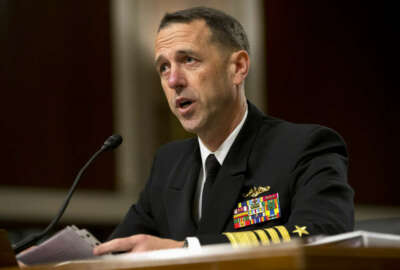A leading military research unit celebrates a century of work
It was established in the steam-power and rotary engine era. And it remains relevant in the nuclear and jet propulsion era. The Naval Research Laboratory (NRL)...
It was established in the steam power and rotary engine era. And it remains relevant in the nuclear and jet propulsion era. The Naval Research Laboratory (NRL) recently marked 100 years in business, and a history of helping U.S. naval forces keep their competitive advantage. For more, Federal Drive Host Tom Temin spoke with Dr. Bruce Danly, NRL’s Director of Research.
Interview Transcript:
Tom Temin And just a quick question out of curiosity. How long have you been with the labs?
Bruce Danly Well, I’ve been here since 1995, so 27 and a half years or so. I came mid-career. My previous career was all at MIT and the Massachusetts area.
Tom Temin Oh, yes. I’ve run across the Smoot Bridge several times myself, and in recent years.
Bruce Danly Myself, I walked across it for four years in a row.
Tom Temin All right. Well, let’s get to the lab here and give us a sense of the scope of technologies and scientific areas that the lab concerns itself with.
Bruce Danly So the lab really, as the Department of Navy’s corporate research laboratory, really services both the Navy and the Marine Corps being the Naval Research Laboratory. And we cover everything from the seafloor up through the water column to the surface, to the atmosphere and meteorology and the atmosphere up to even things happening with the sun and the ionosphere in space, because all of those things have an impact on the operational naval forces. And we work technologies and understanding of the battlespace environment really to support a wide range of Navy missions.
Tom Temin And on the spectrum from basic scientific research all the way through to applied technology, say, where does the laboratory generally fall, would you say?
Bruce Danly So we are strongest in early basic and applied research, but that is not to say that we don’t also do advanced development and even some pushing of technology directly out to the fleet or in concert sometimes with our industry partners. So we do really the whole spectrum. I’d say that it really depends on the research division at the laboratory. We have 17 divisions and some are more centered on longer term basic research. Others are more centered on near-term engineering at higher TRL levels.
Tom Temin And from an operational level is most of the research done by staff, scientists and researchers? Do you also have a grant program, and give us a sense of the balance of who’s actually doing the work and under what types of funding channels?
Bruce Danly Right. So in the Navy, the responsibility for externally funding all the great work that goes on and all the innovation and universities and industry is, that’s the Office of Naval Research responsibility. The Naval Research Laboratory, though we report up to the Chief of Naval Research on the Secretariat side of the Navy, we actually are the in-house performers. So the researchers at NRL are the ones that are actually carrying out their research in our many labs and facilities. And they’re by and large, all civilian employees of the Department of Navy, all scientists and engineers. We have about a thousand PhDs, which is just a little under half of all the PhDs in the Department of Navy.
Tom Temin How do you avoid, say, potential duplication of effort from what’s going on, funded externally through the ONR and what the Naval Research Laboratory is doing?
Bruce Danly So we pay close attention to that and in many cases we end up collaborating with the outside partners that ONR is funding. ONR has what’s called a portfolio council, which I have a a seat at with one of our department heads and we regularly meet, we meet every two weeks and we work to ensure that there’s complimentary of effort and not duplication.
Tom Temin And what about the demand signals? Does the Navy ever say, Hey, we need to know more about this because helicopters and planes are having this particular function or we expect to do this type of mission, or does it generate pretty much from what your own scientists understand, to be the next frontier in a given domain?
Bruce Danly Well, it’s really both. We wouldn’t be doing our fundamental mission if we weren’t innovating to the ideas that we come up with to solve Navy problems. So our recently retired CEO, Captain Petrovic, liked to quote a Henry Ford quote, and that is, if I’d asked people what they needed, they would have said faster horses. And so by that, we expect the Navy to tell us and we learned to the long careers that people spend in the Navy, what the real problem is. And then we innovate not to make faster horses, but to come up with something new, like a car.
Tom Temin We’re speaking with Dr. Bruce Danly. He’s director of research at the U.S. Naval Research Laboratory. And just out of curiosity, what are some of the big problems right now? What are the top concerns that research is being applied to?
Bruce Danly Oh, there’s a whole range of research challenges and and also opportunities to improve technology to the benefit of the Navy. So a few examples. Let me start with corrosion. Coatings, coatings and paints for stopping corrosion on ships at sea. A huge amount of the cost of sustaining the fleet has to do with mitigating corrosion. And so we have a lot of efforts underway that develop new chemistries for new deck coatings that have been successful. One of the Navy’s destroyers is now mostly painted with a new NRL paint, which is showing significantly reduced workload on sailors for repainting to stop corrosion. So that’s one example. It’s really a wide range of things. Ocean scientists. We spent a lot of time studying oceanography at our site down at Stennis, Mississippi, our Ocean Sciences division, to try to understand the impact of ocean currents on sonar propagation as another example. We work a lot on marine meteorology and even on ionospheric propagation effects, because that affects HF communications, for example, that the Navy depends on. So a wide range of things.
Tom Temin It sounds like many of the research products that are coming out of the labs would have commercial and industrial application like especially some of those new coatings or for the shipping industry in the cruise industry, the idea of sonar and currents and all the meteorological learnings.
Bruce Danly So it certainly does. And we actually have a very active tech transfer program with U.S. companies. And the laboratory has a long history of patenting a lot of the work that comes out of here. Department of Navy owns the patent, but NRL has a very good track record of patent licensing. In fact, there was a study by Tech Link, which is a federal entity sponsored by the Department of Defense on national economic impacts from DOD license agreements with U.S. industry over the past 20 years. And NRL, in that study, study came out in September of 22, basically attributed the total output of NRL for a total economic wide impact to be $2.3 billion over that 20 year time period. So we have a big impact with our patent portfolio that get licensed by a lot of really the companies who become partners in taking the patented inventions at the lab and then commercializing them both for DOD use and for commercial use.
Tom Temin And what about adaption of technologies that might not be in the Navy’s possession but could potentially benefit it? I’ll give you an example I just heard about from another interview. There’s a certain type of submarine made in Europe, I think in Sweden that is neither nuclear nor diesel, so therefore it uses oxygen burning systems. But they can stay underwater for weeks, not as long as a nuclear sub, but way longer than a conventionally diesel powered sub. That kind of thing. That could be adapted so the Navy could buy 100 cheap submarines that can stay under for a while, this kind of thing. Do you get involved in reverse technology transfer ever?
Bruce Danly So we certainly get asked questions regularly as a corporate lab at the Navy about technologies that people are trying to understand. We see our foreign partners develop, but the Navy also has naval warfare centers, which are also part of our innovation ecosystem in the Department of Navy. So when you get to propulsion in the actual shipbuilding, that tends to be the naval surface warfare centers, of which NSWC, Carderock is a good example. So we work closely with the Naval Warfare Centers to analyze some of the technologies where it’s closer to less research, but closer to something that’s operational.
Tom Temin And another question, getting back to the idea of, you know, avoiding overlap, and that is we’ve got NOAA, we’ve got different elements of the Commerce Department, the Agriculture Department, even to some extent the National Science Foundation. There’s a lot of research going on throughout the government internally and externally. How do you make sure that there’s not something already done outside of the Navy enterprise altogether that might be useful?
Bruce Danly We actually, our research workforce are card carrying scientists and engineers themselves, and they stay plugged in to the international scientific community through attending scientific conferences, keeping a pulse on what’s happening at universities and spinning off ideas from that and contributing their own ideas into that international innovation ecosystem. That’s the bread and butter of the scientific communities to do that.
Tom Temin And what is your own particular scientific background and expertise?
Bruce Danly So originally got my doctorate degree in quantum electronics at MIT way back in 1983, then evolved into working on high power RF systems before I came to the Naval Research Lab in 95. And then I worked on electronics. I ran radar division for nine years here and have been the director of Research for six and a half.
Tom Temin Yeah, that’s an interesting point. There is always plenty more to learn on even technologies that have been well-established for decades.
Bruce Danly Absolutely. You know, a lot of scientific advance occasionally it’s breakthroughs and new ideas, but a lot of it is building on the ideas of other people. And that’s why collaboration across many different communities and even open literature is so important. And NRL publishes, 800 or 900 publications a year in the open literature because exchange of scientific ideas, basic scientific research is so important not only for us but all of the innovation ecosystem.
Copyright © 2025 Federal News Network. All rights reserved. This website is not intended for users located within the European Economic Area.
Tom Temin is host of the Federal Drive and has been providing insight on federal technology and management issues for more than 30 years.
Follow @tteminWFED







